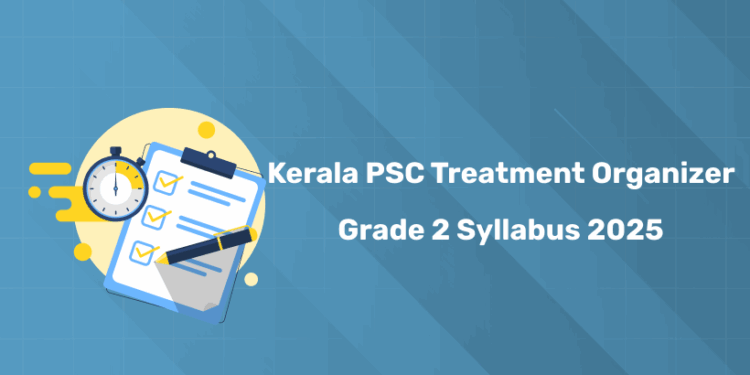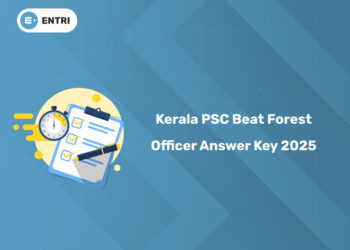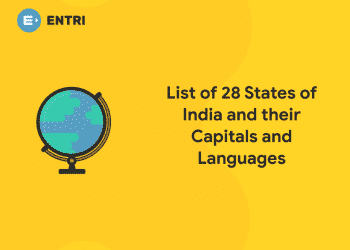Table of Contents
Kerala PSC Treatment Organiser Gr. II (Direct Recruitment) under Health Service 044/2024 will be held on 11/10/2025 (Saturday) from 1:30 PM to 3:20 PM. The exam will be OMR-based, 100 marks, in English, with 1 hour 30 minutes duration. In this blog, we provide the complete syllabus in PDF format, exam pattern. Check it out now!
Kerala PSC Treatment Organiser Grade 2 Exam 2025 Highlights
| Exam Detail | Information |
|---|---|
| Exam Name | Kerala PSC Treatment Organiser Grade II |
| Category | Health Services 044/2024 |
| Exam Date | 11th October 2025 (Saturday) |
| Exam Time | 1:30 PM – 3:20 PM |
| Exam Mode | OMR-based |
| Total Marks | 100 |
| Duration | 1 hour 30 minutes |
| Admit Card Release Date | 27th September 2025 |
| Mandatory Documents | Admit Card, Valid ID Proof |
| Official Website for Updates | Kerala PSC |
Kerala PSC Treatment Organiser Grade 2 Syllabus 2025 PDF
1: Which Year First Assembly Election was held in Kerala?
Candidates appearing for the Kerala PSC Treatment Organiser Grade II (Health Service) examination can now download the official Syllabus 2025 PDF. The syllabus includes detailed topics, subject-wise marks distribution, and the exam pattern for better preparation. Download now!
Enroll in Kerala's Top-rated Kerala PSC Coaching Program!
സർക്കാർ ജോലി എന്ന സ്വപ്നം ഇനി സ്വപ്നം മാത്രമല്ല! Join Entri's Kerala PSC Coaching Programs
Join Now!Kerala PSC Treatment Organiser Grade 2 Exam Pattern 2025
Kerala PSC Treatment Organiser Grade II Exam 2025 will be conducted in OMR format for a total of 100 questions carrying 100 marks. The medium of the exam will be English, and the duration is 1 hour 30 minutes. Each question carries one mark, and there will be a negative marking of 1/3 mark for every wrong answer.
| Part | Subject | Modules | Marks |
|---|---|---|---|
| Part I | Physics (30 Marks) | Module I – 8 Marks
Module II – 6 Marks Module III – 8 Marks Module IV – 8 Marks |
30 |
| Part II | Chemistry (28 Marks) | Module I – Physical Chemistry – 8 Marks
Module II – Inorganic Chemistry – 10 Marks Module III – Organic Chemistry – 10 Marks |
28 |
| Part III | Botany (14 Marks) | Module I – Cell Structure and Function – 2
Marks Module II – Reproduction – 4 Marks Module III – Biology in Human Welfare – 2 Marks Module IV – Biotechnology – 4 Marks Module V – Ecology – 2 Marks |
14 |
| Part IV | Zoology (14 Marks) | Module I – Human Physiology – 6 Marks
Module II – Genetics – 4 Marks Module III –Biology in Human Welfare – 2 Marks Module IV – Animal Kingdom – 2 Marks |
14 |
| Part V | Mathematics | — | 14 |
Kerala PSC Treatment Organiser Grade 2 Detailed Syllabus 2025
Candidates should note that, apart from the topics listed above, questions from other subjects related to the prescribed educational qualification for the post may also be included in the examination. There is no guarantee that all topics mentioned in the syllabus will be covered in the question paper.
PART I : PHYSICS (30Marks)
Module I – 8 Marks
Units and Measurements:
System of Units – CGS and S.I System, Multiples & sub multiples of unit, Parallax method – for measurement of large distances, Significant figures, Accuracy and Precision, Errors in measurement and Calculation.
Kinematics – Motion in a straight line and plane.
Graphical representation of motions – Position time graph and velocity time graph, Equation of motion, Displacement and distance, Velocity and acceleration, Vector addition – Triangular law and Parallelogram law, Uniform circular motion – Centripetal force and acceleration.
Dynamics – Laws of motion and Work, Energy & Power.
Newton’s laws of motion, Impulse and its application, Law of conservation of momentum – Recoil of gun, Friction – Laws of static and kinetic friction, angle of repose, Methods of reducing friction. Different types of work, Kinetic and Potential energy, Power, Collision -Elastic and Inelastic collision.
System of Particles and Rotational motion & Gravitation
Law of conservation of angular momentum and its application, Torque and Angular momentum, Moment of Inertia of regular bodies – Ring, disc, sphere and Cylinder, Theorem on Moment of Inertia – Parallel axes and Perpendicular axes, Kinetic energy of rolling bodies Acceleration due to gravity (g) and its variation with depth and height, Orbital velocity and time period of satellite, Escape velocity, Kepler’s third law.
Module II – 6 Marks
Mechanics of Solids and fluids
Elasticity – Stress and strain, Moduli of elasticity -Young, Bulk and rigidity, Stress strain graph, Fluid pressure, Pascal’s law and its applications, Surface tension, Viscosity, Bernoulli’s theorem and its application, Equation of continuity, terminal velocity
Heat and Thermodynamics
Principle of mixture, Scales of temperature, Specific heat capacity, First and second law of thermodynamics, Isothermal and adiabatic process, Carnot’s Heat engine.
Oscillation & Waves
Simple Harmonic Motion (SHM), simple pendulum, Longitudinal and transverse waves, Vibration in air column – Open pipe and closed pipe, Beats and doppler effect.
Module III – 8 Marks
Electrostatics
Quantization of charge, Coulomb’s law, Electric field, Gauss’s theorem and its application, Equi potential surfaces, Capacitance, Parallel plate capacitor, combination of capacitors -series & Parallel.
Electro dynamics- Current Electricity
Ohm’s law, Electric current and current density, Colour code of resistors, Resistivity and conductivity, Drift velocity and mobility, Potentiometer.
Moving charges and magnetism
Biot-Savart’s law and its application – circular coil, Solenoid and Toroid, Galvanometer to ammeter and voltmeter, Classification of magnetic materials – dia, para and ferro materials, Magnetic field lines.
Electromagnetic induction & AC
Faraday’s laws, Eddy current and its applications, Self induction, AC generator, Transformers, Wattless current and Q-factor of LCR circuit, Reactance of ac circuits.
Electromagnetic waves
Properties of Electro magnetic waves and its uses, Electromagnetic spectrum.
Module IV – 8 Marks
Ray and Wave optics
Reflection of spherical mirrors, Refraction and its application, Total internal reflection and its applications, Lens maker’s formula, Power of a lens, Combination of lens, Scattering and dispersion, Microscope, Interference -Young’s double slit experiment, Polarisation -Malu’s law and Brewster’s law.
Modern Physics – Dual nature of radiation & matter, Atoms & nuclei
Photo electric effect, Einstein’s Photo electric equation, Matter waves, Bohr atom model -Spectral series of Hydrogen atom, Half life period and nuclear reactor.
Semiconductor physics
Concept of Energy band – Classification of materials – conductor, insulators and semiconductors, Properties of semiconductors, Dopping, Intrinsic and extrinsic semiconductor, N type and P type semiconductors, P N junction diode, Half wave and full wave rectifiers, Zener diode, Photo diode and LED.
PART II : CHEMISTRY (28 Marks)
Module I : Physical Chemistry (8 Marks)
Some basic concepts of chemistry-mole concept calculation, definition of molarity, molaritycalculations.
Structure of atom-Different atom model –Rutherford, Neils Bohr, concepts of orbitals,quantum number,shape of s,p,and d orbitals, rules for filling electrons in orbitals
Equilibrium- concept of PH
Electrochemistry-Different types of electrochemical cells(Galvanic ,also called voltaic and electrolytic)
Surface chemistry – Colloids and emulsions- type of colloids with examples –colloids around us
Moduel II : Inroganic Chemistry (10 Marks)
Periodic classification of elements- Modern periodic table and the present form of periodic table,periodic trends in properties and their variation along a group and period with reason– atomic radii, electronegativity
Hydrogen – Types of water- Hardness of water-causes of hardness and its
removal,Hydrogen peroxide
S-block elements -Biological importance of sodium and calcium
P-Block elements- Allotrops of diamond and Graphite their structure and properties,Compouds of nitrogen –Ammonia and Nitric acid ,compounds of Sulphur sulphuric acid
Applications of d & f block elements
Moduel III : Organic Chemistry (10 Marks)
Organic chemistry some Basic principles and techniques- IUPAC nomenclature of organic compounds, Different method used for purification of organic compoudsdistillation,crystallization,sublimation
Hydrocarbons –General formula of alkanes
Test for alcohols,phenol,aldehydes ,ketones
Alcohol -Isopropyl alcohol,glycerol
Chemistry in Everyday life –Chemistry in food ,medicines (Anticeptic, antibiotic)
,cleansing agents
Biomolecules-Carbohydates,proteins,vitamins ,nucleic acids
Polymers-Poly styrene,Polyurethane,Silicones,Poly carbonates,Polyether,Polyester
PART : III BOTANY (14 marks )
MODULE I : CELL STRUCTURE AND FUNCTION ( 2 Marks)
CELL THE UNIT OF LIFE
- Cell Theory
- Prokaryotic and Eukaryotic cells
- Cell organelles – Structure and function.
CELL CYCLE AND CELL DIVISION
- Cell Cycle
- Phases of cell cycle – Interphase , Mitosis , Meiosis
MODULE II : REPRODUCTION ( 4 Marks)
REPRODUCTION IN ORGANISMS
- Asexual reproduction – Methods
- Vegetative propagules
- Sexual reproduction – Events , Ovipary, Vivipary.
SEXUAL REPRODUCTION IN FLOWERING PLANTS .
- Stamen, Microsporangium, Pollen grain – Structure and development.
- Pistil , Megasporangium ( Ovule ) – Structure and development.
- Pollination , Outbreeding devices
- Artificial hybredisation
- Double fertilization
- Endosperm , Embryo , Seed
- Apomixis , Polyemryony.
MODULE III: BIOLOGY IN HUMAN WELFARE ( 2 Mark )
STRATEGIES FOR ENHANCEMENT IN FOOD PRODUCTION .
- Animal husbandry
- Management of farms and farm animals , Animal breeding , Bee keeping , Fisheries
- Plant breeding ,Biofortification
- Single cell protein
- Tissue culture.
MODULE IV : BIOTECHNOLOGY ( 4 Marks )
BIOTECHNOLOGY PRINCIPLES AND PROCESSES
- Principles of biotechnology
- Tools of recombinant DNA technology
- Separation and isolation of DNA fragments ( Gel electrophoresis )
- Cloning vectors
- Process of recombinant DNA technology – Isolation of DNA, Amplification of gene of interest using PCR , Obtaining foreign gene product , Downstreaming process.
BIOTECHNOLOGY AND ITS APPLICATIONS
- Biotechnological applications in agriculture
- Biotechnological applications in medicine
- Transgenic animals
- Ethical issues
MODULE V : ECOLOGY ( 2 Marks )
ORGANISMS AND POPULATIONS
- Organisms and its environment , Abiotic factors , Response to abiotic factors
- Adaptations
- Populations – Population attributes , Population growth , Life history variation , Population interactions .
ECOSYSTEM
- Ecosystem-Structure and Function
- Productivity
- Decomposition
- Energy flow
- Ecological Pyramids
- Ecological Succession – Hydrarch Succession , Xerarch Succession.
- Nutrient cycling.
ENVIRONMENTAL ISSUES
- Pollution – Air , Water
- Greenhouse effect and global warming ,Ozone depletion
- Deforestation , Reforestation
- People’s participation in conservation of forests
PART IV : ZOOLOGY (14 Marks)
MODULE I : HUMAN PHYSIOLOGY (6 marks)
DIGESTION AND ABSORPTION
Parts of Human Digestive system, Mechanism of Carbohydrate, Protein and fat digestion
BREATHING AND EXCHANGE OF GASES
Parts of Human Respiratory system, Mechanism of Breathing in man, Transport of Carbon dioxide and oxygen through blood
BODY FLUIDS AND CIRCULATION
Structure of Human heart, Cardiac cycle, ECG
EXCRETORY PRODUCTS AND THEIR ELIMINATION
Parts of Human kidney, Process of Urine Formation, Hormonal regulation of Kidney Function
LOCOMOTION AND MOVEMENT
Three types of muscles, Mechanism of muscle Contraction, Human skeleton, Types of Joints
NEURAL CONTROL AND COORDINATION
Structure of Neuron, Parts of human brain, Structure of Eye and Ear
CHEMICAL COORDINATION AND INTEGRATION
Endocrine glands, hormones and their functions
HUMAN REPRODUCTION
Structure of Male and Female reproductive system, Gametogenesis, Fertilization, Implantation, Functions of Placenta, Embryonic development,
REPRODUCTIVE HEALTH
Sexually transmitted diseases, Contraceptives, Assisted Reproductive Technologies
MODULE II : GENETICS (4 marks)
HEREDITY AND VARIATION
Non Mendelian inheritance – Co dominance, Multiple alleles Chromosomal and Mendelian disorders, Sex determination in humans
MOLECULAR BASIS OF INHERITANCE
Structure and functions of DNA, Central Dogma-Transcription and Translation, DNA Finger printing
MODULE III : BIOLOGY IN HUMAN WELFARE (2 mark)
HUMAN HEALTH AND DISEASES
Types of Immunity, Immune system of human body, Allergy, AIDS, Cancer
Module IV: ANIMAL KINGDOM (2 marks)
Characteristic features and examples of different phyla (Porifera, Coelenterate, Platyhelminthes, Aschelminthes, Annelida, Arthropoda, Mollusca Echinodermata, Chordate)
PART V – MATHEMATICS – 14 MARKS
- Sets (Type of sets, subset, set operations etc .)
- Relations (Type of relations ,Number of relations from a set A to B etc.)
- Functions ( Type of functions ,Domain and range etc. )
- Factorial of numbers (Position of a word ,Number of arrangements etc. )
- Progression( Arithmetic Progression ,Geometric progression)
- Trigonometry (Questions based on standard results and values)
- Conic (Latus rectum ,eccentricity ,focus etc. of ellipse ,Parabola )
- Vector (Perpendicular vector ,Parallel vector ,dot product)
- Derivatives (Derivatives of some standard functions)
- Straight Line (slope ,intercept etc.)
How to Download Kerala PSC Treatment Organiser Grade 2 Syllabus 2025
- Visit the official Kerala PSC website – www.keralapsc.gov.in.
- Go to the “Recruitment” section from the main menu.
- Click on “Syllabus” from the dropdown list.
- Search for “Treatment Organiser Grade II (Health Service) – Category No. 044/2024”.
- Click on the Download button to get the official syllabus PDF.
- Save the file for reference











